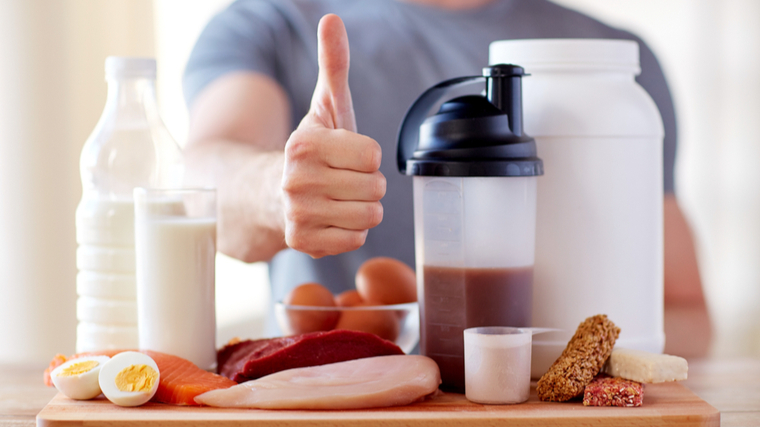You’ve probably heard of the term “use it or lose it.” That phrase could easily be applied to your muscles. Even the most dedicated gymgoer has days where they’re less motivated to hit the iron, or life forces them to take an extended break. However, if you’re off your game too long, there will be consequences.
Your body is resilient, but the muscle you put on won’t stick around forever if you don’t challenge it. Although rest days are important for recovery, staying active regularly can help maintain your strength or physique long-term. Muscle maintenance is not only important for keeping your desired physique, it also factors into injury prevention and lower risk of disease.

In order to keep your hard-earned muscle on, it’s important to understand the physiological processes happening behind the scenes. Here’s everything you need to know about muscle behavior, and how to keep what you’ve gained.
How to Maintain Muscle
- How Muscle Maintenance Works
- Why Muscle Loss Happens
- How to Train to Maintain Muscle
- Workout Splits for Muscle Maintenance
- Sets and Reps for Muscle Maintenance
- Nutrition for Muscle Maintenance
- The Importance of Recovery
Editor’s Note: The content on BarBend is meant to be informative in nature, but it should not be taken as medical advice. When starting a new training regimen and/or diet, it is always a good idea to consult with a trusted medical professional. We are not a medical resource. The opinions and articles on this site are not intended for use as diagnosis, prevention, and/or treatment of health problems. They are not substitutes for consulting a qualified medical professional.
How Muscle Maintenance Works
You might work your muscles on a regular basis, but you still need to understand the nature of muscularity in order to help preserve it. The Wiley Interdisciplinary Review defines skeletal muscle as, “a set of innervated, voluntary cells that exhibit fatigue with high energy requirements.” (1)
When exercised regularly with progressive overload, mixed with proper nutrition and recovery, muscle has the ability to grow, known as hypertrophy. That said, there’s a slightly different ruleset in play when maintenance is your goal.
Studies suggest that resistance training is beneficial for maintaining muscle and strength, which is especially important for older populations. (2) However, bodyweight exercises shouldn’t be discounted since they can accrue several benefits of their own.
If you’re unable to make it to the gym or eat enough calories to put on mass, keeping the gains you’ve already made should be a top priority — whether you do so via lifting or calisthenics. More than anything, the distinction between growth and maintenance is about how you dose your workout stimulus and nutrition.
Why Muscle Loss Happens
Muscle loss is the reduction in the size of muscle fibers and can be a result of aging, lack of exercise, poor nutrition, or medical maladies. While muscular atrophy in healthy individuals is generally a byproduct of inactivity, it can also be an unfortunate side effect of specific medical conditions like sarcopenia or cachexia. (3)
Furthermore, research has shown that muscle loss is strongly associated with greater risks of certain chronic diseases and is a reliable indicator in all-cause mortality rates. (4) Aging also strongly impacts muscle wasting — after age 30, you may drop up to 8% of your muscle mass every decade, a process that rapidly increases after 60.

While it may seem like an inescapable fate, you can get out in front of muscle loss with physical training and a high-protein diet. Taking your muscularity seriously isn’t only important for lifting heavy in the gym — muscle mass may also lower the risk of obesity, heart disease, osteoporosis, injuries, and more. (5)
How to Train to Maintain Muscle
Building muscle is hard, but luckily, maintaining it can be easy — if you go about it properly. A training program focused on maintenance can look different than one for bodybuilding or strict weight loss. Whether your program of choice includes calisthenics, resistance training, or both, training the proper amount combined with the proper nutrition can help you maintain your chest or quad gains.
While gaining lean mass might necessitate long, grueling hours in the gym, you can get by and maintain your progress on comparatively “lighter” training. Studies suggest that to maintain muscle, resistance training just one to two times per week may be enough. Three sets of 10 repetitions is a science-backed benchmark for general muscle maintenance. (6)
It’s worth noting that your body, and thus your needs, are unique. If you’re trying to keep what you’ve earned, your training program will likely look different than your training partner’s.
More advanced trainees who have been in the gym longer will probably need more work in general to maintain their gains, since they did more serious work to get them. When finding your maintenance volume, err on the side of more at first and trim down as needed over time.
Workout Splits for Muscle Maintenance
Walking into the gym without a plan is a mistake. Programs aren’t a one-size-fits-all deal, but there are standard practices to follow for muscle maintenance. If you were trying to build muscle, progression in weight or reps would be a big focus — however, focusing on maintenance might not necessitate as much volume or frequency.
Fortunately, the same workout structure you use while bulking up or cutting down generally serves fine as a program for muscle maintenance, as long as you keep tabs on your overall workload. Here are a couple of popular ways to organize your training during a maintenance phase:
Body Part Split
A basic body part split is straightforward — you train each muscle or muscle group on a specific day in the week. Body part splits are popular for muscular maintenance because if you’re only working out once or twice per week, you can hit all the major muscle groups every time.
Upper/Lower
This program structure splits upper body and lower body into two separate days. This can be beneficial for lifters who may need more overall volume to maintain their muscle, or who want to get some extra technical practice even during maintenance phases.
Push/Pull/Legs
This program splits pushing exercises, such as push-ups and shoulder presses, pulling exercises, such as pull-ups and rows, and legs, such as squats and lunges, across three different days. This split provides three high-volume, intense sessions to ensure you’re covering your bases. However, these workouts will be more demanding and thus require more dedicated recovery.
You can also maintain muscle by following a full-body routine. That said, splits are generally more appropriate for maintenance since they reduce the amount of time spent in the gym overall and help naturally control for volume levels.
Sets and Reps for Muscle Maintenance
Once you’ve determined your exercises, it’s time to figure out how many reps to complete, how many sets of those reps, and the weights you should use. Since maintenance is the goal, you’re typically looking for less weight and more volume.
Since you’ll be in the gym less than you were when you were building muscle, you might want to use high-volume training as a way to both stimulate your muscles and make sure you’re moving throughout the day.

[Read More: The Best Upper Body Exercises and Workouts]
This means your weight should be light enough to get you through a higher amount of reps. For bigger muscles — chest, legs, and back — use a heavier weight than you would for smaller muscles like the arms and shoulders. You’ll also want to start your workout with compound exercises like the squat or deadlift and leave the isolation exercises for last.
For general muscle and strength maintenance, start with 70 to 80% of your one-rep-max for three sets of eight or more reps. If you’re particularly focused on maintaining your strength as well, kicking up the weight occasionally is a smart move. However, for holding onto muscle specifically, you shouldn’t be afraid to train in higher rep ranges in lieu of loading up on plates.
Nutrition for Muscle Maintenance
Of course, you might be even more drawn to comfort foods now than you are when you’re deep into a heavy training cycle. Remember, though, that nutrition is equally important when maintaining your gains as it is when adding new muscle.
Maintaining your muscle requires enough calories and sufficient protein to ensure you don’t chew through lean mass during your workouts. As long as you’re getting enough protein in and aren’t in a caloric deficit, you’ll be on solid ground regarding muscular maintenance.
To determine how many calories you need to maintain (or gain) weight, you can check out this calculator:
Calorie Calculator
The Importance of Recovery
For some lifters, not going to the gym can take just as much motivation as actually going to the gym. Rest days might feel like a struggle, but they are essential, and you might be resting more during a maintenance phase.
Recovery days can be just as important as gym days because they allow your muscles to repair and help prevent overtraining, which comes with negative side effects of its own. Some researchers recommend resistance training two to three days per week, 48-72 hours apart. The time between training sessions showed to be beneficial for recuperating muscle and strength. (7)
[Read More: Best Upper Chest Exercises for Building Muscle]
It’s important to note that even on rest days, adequate nutrition should still be followed and just because you didn’t exercise, doesn’t mean your body doesn’t need the same amount of calories or macros.
So if you’re looking for an excuse to sit around all day, maybe catch up on your favorite show, take a rest day. It’s good for you.
Wrapping Up
Maintenance isn’t as glamorous as gaining or losing weight. However, life doesn’t always allow for a picture-perfect bulking routine, or you simply may not want to change your body any further.
Phasing yourself out of a weight-adjustment routine and into a period of balance is as simple as tuning the dials of your nutrition and training. Get your caloric intake to match your activity level and, if needed, wean down on your workout intensity a bit. As long as you keep your protein intake high and workouts moderately challenging, you can keep what you’ve built with no problem at all.
Looking for more tips on muscle maintenance and nutrition? Check out our other articles below.
- How to Count Macros for Weight Loss, Muscle Gain, and Maintenance
- So You’re Jogging More Than Ever – Here’s How To Maintain Muscle Mass
- Anabolic Vs. Catabolic — How To Build Muscle And Keep It
References
- Mukund, Kavitha, Subramaniam, Shankar. Skeletal Muscle: A Review of Molecular Structure and Function, in Health and Disease. Wiley Interdisciplinary Reviews. Systems Biology and Medicine. 2019; 12(1). doi: 10.1002/wsbm.1462
- Pollock, Michael L., Franklin, Barry A., & Balady, Gary J. Resistance Exercise in Individuals With and Without Cardiovascular Disease. Circulation. 2000; 101. doi.org/10.1161/01.CIR.101.7.828
- Evans, William J. Skeletal Muscle Loss: Cachexia, Sarcopenia, and Inactivity. The American Journal of Clinical Nutrition. 2010; 91(4). doi.org/10.3945/ajcn.2010.28608A
- Wilkinson, DJ, Piasecki, M, Atherton, PJ. The age-related loss of skeletal muscle mass and function: Measurement and physiology of muscle fibre atrophy and muscle fibre loss in humans. Ageing Research Reviews. 2018; 47. doi: 10.1016/j.arr.2018.07.005
- Volpi, Elena, Nazemi, Reza, Fujita, Satoshi. Muscle tissue changes with aging. Current Opinion in Clinical Nutrition and Metabolic Care. 2004; 7(4).
- Trappe, Scott, Williamson, David, Godard, Michael. Maintenance of whole muscle strength and size following resistance training in older men. The Journals of Gerontology. 2002; 57(4). DOI: 10.1093/gerona/57.4.b138
- Yang, Yifan, Bay, Pang B., & Wang, Yongtai R. Effects of Consecutive Versus Non-consecutive Days of Resistance Training on Strength, Body Composition, and Red Blood Cells. Frontiers in Physiology. 2018; 9. doi: 10.3389/fphys.2018.00725
Featured Image: Jacob Lund / Shutterstock